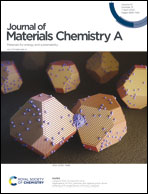Highly efficient water harvesting of bioinspired spindle-knotted microfibers with continuous hollow channels†
Abstract
Fog, as a potential freshwater source, can be exploited to address global freshwater scarcity risk. The unique periodic knot structure of natural spider silk inspires the development of microfibers for collecting freshwater from atmospheric air. Improving the water collection ability of microfibers remains an ongoing challenge. In this work, bioinspired spindle-knotted microfibers with continuous hollow channels were fabricated by a simple and flexible multiphase-laminar-flow microfluidic method, and the structure and morphology can be precisely manipulated by adjusting flow rates. Noticeably, the compartmental effect of an aqueous two-phase system (ATPS) was introduced for forming stable hollow spindle-knotted microfibers (HSFs). Compared to that of solid spindle-knotted microfibers (SSFs), HSFs exhibit greater hanging ability, growth speed of droplets and water collection efficiency. The mechanism revealed was that the unique hollow structure brings up extra capillary force and offers longer lengths to the three-phase contact line (TCL) for water collection behavior, and enhances the water collection ability of HSFs. The maximum droplet volume is almost 1663 times that of the microfiber knot, which is the largest volume ratio of droplet to knot compared to previously reported fibers. The continuous HSFs show great potential in large-scale water collection, directional liquid transportation and drug release.



 Please wait while we load your content...
Please wait while we load your content...